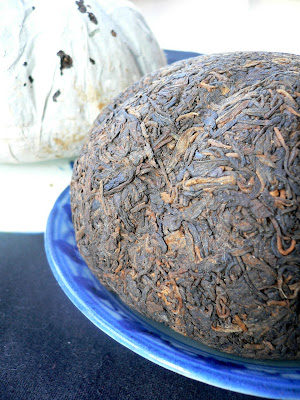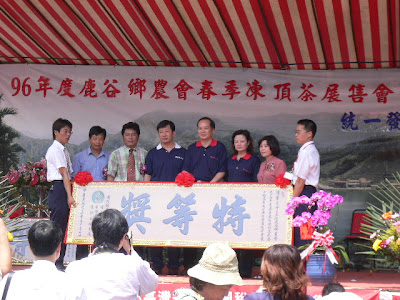12 photos pour célébrer l'année qui s'achève. Certaines sont inédites!












 -Un grand merci pour tous vos commentaires. Ce sont comme autant de cadeaux que vous m'offrez à moi et aux autres lecteurs.
-Un grand merci pour tous vos commentaires. Ce sont comme autant de cadeaux que vous m'offrez à moi et aux autres lecteurs..jpg) - Dans les semaines suivantes, j'aurai certainement l'occasion de vous dévoiler de nouvelles nappes à thé faites par ma mère, mes plus jolis cadeaux de ce Noël.
- Dans les semaines suivantes, j'aurai certainement l'occasion de vous dévoiler de nouvelles nappes à thé faites par ma mère, mes plus jolis cadeaux de ce Noël. A High Mountain Oolong is excellent when the fragrance, the taste and the qi all convey the feeling of being on the mountain where the tea comes from.
A High Mountain Oolong is excellent when the fragrance, the taste and the qi all convey the feeling of being on the mountain where the tea comes from.  Taiwan is not just a big industrial and high tech island, but also home to a lot of beautiful mountains. Many trails are less than an hour drive away from where I live. To see more pictures of this green island, there is this very promising Hiking blog. It reminds me of the nice runs I used to have with the Taipei Hash.
Taiwan is not just a big industrial and high tech island, but also home to a lot of beautiful mountains. Many trails are less than an hour drive away from where I live. To see more pictures of this green island, there is this very promising Hiking blog. It reminds me of the nice runs I used to have with the Taipei Hash.
 The only thing that beats drinking tea or hiking in the mountains is to have tea in the mountains!
The only thing that beats drinking tea or hiking in the mountains is to have tea in the mountains!
 With a tea mat:
With a tea mat: MERRY CHRISTMAS!
MERRY CHRISTMAS!


.jpg)
.jpg)
.jpg)


 A propos de mon article précédent, Michel me demande quel est le goût de l'eau provenant d'une bouilloire en glaise spécialement conçue pour le thé. Remarquons d'abord que ce genre de bouilloire est très populaire dans les maisons de thé taiwanaises. Le fait d'avoir une flamme (bruleur à alcool) donne une atmosphère plus classique qu'un chauffe-eau électrique sans les difficultés associées à un vrai feu de braises. Les autres avantages sont la légèrté du matériel et le coût relativement peu élevé. Si bien qu'un set tel celui ci-dessous coûte moins de 100 euros (bouilloire, plateau en bambou et porcelaine blanche). C'est dire si la pratique du gongfu cha n'est élitaire que par le temps qu'elle occupe (embellit) et la vaste culture à laquelle elle donne accès.
A propos de mon article précédent, Michel me demande quel est le goût de l'eau provenant d'une bouilloire en glaise spécialement conçue pour le thé. Remarquons d'abord que ce genre de bouilloire est très populaire dans les maisons de thé taiwanaises. Le fait d'avoir une flamme (bruleur à alcool) donne une atmosphère plus classique qu'un chauffe-eau électrique sans les difficultés associées à un vrai feu de braises. Les autres avantages sont la légèrté du matériel et le coût relativement peu élevé. Si bien qu'un set tel celui ci-dessous coûte moins de 100 euros (bouilloire, plateau en bambou et porcelaine blanche). C'est dire si la pratique du gongfu cha n'est élitaire que par le temps qu'elle occupe (embellit) et la vaste culture à laquelle elle donne accès. 
 Conclusion: cette bouilloire noire va bien avec les Oolongs verts et de haute montagne. Elle souligne leur fougue et leur fraicheur. Avec bien moins de finesse et de pureté que l'eau d'une bouilloire en argent, certes, mais à bien meilleur prix. Le fer de la tetsubin, lui, montre encore qu'il convient bien mieux aux thés moelleux et longs en bouche.
Conclusion: cette bouilloire noire va bien avec les Oolongs verts et de haute montagne. Elle souligne leur fougue et leur fraicheur. Avec bien moins de finesse et de pureté que l'eau d'une bouilloire en argent, certes, mais à bien meilleur prix. Le fer de la tetsubin, lui, montre encore qu'il convient bien mieux aux thés moelleux et longs en bouche. Yesterday, at a friend's house, I had the chance to drink old puerh made with spring water boiled with burning (longyan wood) charcoal on a Nilu similar to the one I have (picture on the left). Each time I drink tea boiled with charcoal fire, it tastes rounder and sweeter than usual. Using this traditional way changes the whole atmosphere. A little bit like BBQ means 'party', burning charcoals warms more than just the water...
Yesterday, at a friend's house, I had the chance to drink old puerh made with spring water boiled with burning (longyan wood) charcoal on a Nilu similar to the one I have (picture on the left). Each time I drink tea boiled with charcoal fire, it tastes rounder and sweeter than usual. Using this traditional way changes the whole atmosphere. A little bit like BBQ means 'party', burning charcoals warms more than just the water... Boiled in the (unglazed) iron tetsubin, the water felt rounder, sweeter. I felt a tiny bit of iron taste.
Boiled in the (unglazed) iron tetsubin, the water felt rounder, sweeter. I felt a tiny bit of iron taste. 
 Ce thé est fait avec du luanze Oolong jeune récolté à San Hsia cet automne et fait en thé vert. Puis, on l'a mis en contact avec des fleurs de jasmin en octobre, juste avant leur éclosion. Et comme le thé s'imprègne facilement des odeurs de son environnement, il finit par sentir le jasmin.
Ce thé est fait avec du luanze Oolong jeune récolté à San Hsia cet automne et fait en thé vert. Puis, on l'a mis en contact avec des fleurs de jasmin en octobre, juste avant leur éclosion. Et comme le thé s'imprègne facilement des odeurs de son environnement, il finit par sentir le jasmin.  Ci-dessous, vous pouvez voir le résultat de 4 grammes de thé au jasmin infusé 2 minutes dans un set de compétition. C'est assez concentré! Il s'en dégage un élément chaud et sucré en plus de l'odeur intense de jasmin. Certes, il y a un peu d'astringence (du aux feuilles coupées), mais également une longueur en bouche qui fait que le bouquet de jasmin frais reste un certain temps.
Ci-dessous, vous pouvez voir le résultat de 4 grammes de thé au jasmin infusé 2 minutes dans un set de compétition. C'est assez concentré! Il s'en dégage un élément chaud et sucré en plus de l'odeur intense de jasmin. Certes, il y a un peu d'astringence (du aux feuilles coupées), mais également une longueur en bouche qui fait que le bouquet de jasmin frais reste un certain temps.  L'autre raison pour avoir ajouté ce thé à ma sélection, est qu'il est parfois judicieux d'avoir un thé fleuri assez bon marché qui puisse servir d'alternative aux précieux Gao Shan Cha ou puerhs anciens quand on a de la visite nombreuse qui vous demande de faire votre meilleur thé. Ils ne seront pas déçus. (Une autre alternative, plus courageuse car plus exotique, et meilleure marché, est mon Oolong Si Ji Chun de Mingjian).
L'autre raison pour avoir ajouté ce thé à ma sélection, est qu'il est parfois judicieux d'avoir un thé fleuri assez bon marché qui puisse servir d'alternative aux précieux Gao Shan Cha ou puerhs anciens quand on a de la visite nombreuse qui vous demande de faire votre meilleur thé. Ils ne seront pas déçus. (Une autre alternative, plus courageuse car plus exotique, et meilleure marché, est mon Oolong Si Ji Chun de Mingjian).  Je profite d'un petit répit dans vos commandes pour déguster quelques feuilles de mon puerh sauvage de Lincang. Et comme le dit le caractère peint dans la tasse, c'est du Bonheur!
Je profite d'un petit répit dans vos commandes pour déguster quelques feuilles de mon puerh sauvage de Lincang. Et comme le dit le caractère peint dans la tasse, c'est du Bonheur! 
 Taiwan is mostly home to Oolong, semi-oxidized tea. It is famous for its High mountain Oolongs, which are particularly low oxidized. However, in recent years, there is a trend (a diversification) towards highly or completely oxidized teas. The Guei Fei Cha I wrote about in my last post is an example of this trend. Another good example is the Red tea based on Da Yeh Oolong from the East Coast. And Taiwan's Tea Research and Extension Station is fueling these innovations with R&D on new tea cultivars designed for red tea production: Their last 5 new tea cultivars (No 18 to 22) are all designed to make red tea.
Taiwan is mostly home to Oolong, semi-oxidized tea. It is famous for its High mountain Oolongs, which are particularly low oxidized. However, in recent years, there is a trend (a diversification) towards highly or completely oxidized teas. The Guei Fei Cha I wrote about in my last post is an example of this trend. Another good example is the Red tea based on Da Yeh Oolong from the East Coast. And Taiwan's Tea Research and Extension Station is fueling these innovations with R&D on new tea cultivars designed for red tea production: Their last 5 new tea cultivars (No 18 to 22) are all designed to make red tea. The new red tea I'm about to introduce is not made with a new cultivar. On the contrary, it is made with the most traditional Taiwan tea tree: the luanze (Qingxin) Oolong. It is made with organically leaves grown in Nantou in Spring 2007. They have been fully oxidized AND then roasted four times!
The new red tea I'm about to introduce is not made with a new cultivar. On the contrary, it is made with the most traditional Taiwan tea tree: the luanze (Qingxin) Oolong. It is made with organically leaves grown in Nantou in Spring 2007. They have been fully oxidized AND then roasted four times! This innovation is so new that the farmer hasn't found a name to describe this tea, yet. He has asked for my readers' help. If anybody has a suggestion after tasting it, please let me know (by e-mail). The 3 best entries will receive prizes. The first prize is this RED clay Yixing Shui Ping teapot. And, who knows, maybe one of you will write tea history and become the inventor of this tea's name!
This innovation is so new that the farmer hasn't found a name to describe this tea, yet. He has asked for my readers' help. If anybody has a suggestion after tasting it, please let me know (by e-mail). The 3 best entries will receive prizes. The first prize is this RED clay Yixing Shui Ping teapot. And, who knows, maybe one of you will write tea history and become the inventor of this tea's name!